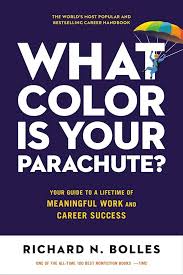The Color of Your Parachute: A Comprehensive Guide to Career Exploration and Development
Executive Summary
This white paper explores the concept of "parachute color" as a metaphor for career exploration and development. It delves into the psychological and practical implications of identifying and pursuing one's passions and strengths to achieve a fulfilling and meaningful career. The paper outlines a framework for self-discovery, leveraging various tools and techniques to assess interests, values, skills, and personality traits. Furthermore, it discusses the importance of continuous learning, adaptability, and networking in navigating the evolving job market.
1. Introduction
The phrase "What color is your parachute?" is a popular metaphor for career exploration, derived from the book of the same name by Richard N. Bolles. It encourages individuals to think beyond traditional job-seeking strategies and delve deeper into self-discovery to identify fulfilling career paths. This paper aims to provide a comprehensive framework for individuals to understand and apply this concept effectively.
2. The Parachute Metaphor
The parachute metaphor suggests that individuals are not simply falling aimlessly through life. Instead, they have the potential to actively shape their career trajectory by identifying their passions, strengths, and values. Just as a parachute guides a safe descent, self-awareness and intentional planning can guide individuals towards fulfilling career outcomes.
3. The Importance of Self-Discovery
- Identifying Interests and Passions: Exploring personal interests and passions is crucial for identifying potential career paths that align with intrinsic motivations. This can be achieved through introspection, journaling, and engaging in diverse experiences.
- Assessing Skills and Strengths: Identifying and developing core skills and strengths provides a foundation for career success. This can involve self-assessment tools, skills inventories, and seeking feedback from others.
- Clarifying Values: Understanding personal values helps individuals identify work environments and cultures that align with their ethical and moral compass. This can be explored through value clarification exercises and introspection.
- Personality Assessment: Understanding personality traits can provide insights into preferred work styles, interpersonal dynamics, and suitable career environments. Tools like the Myers-Briggs Type Indicator (MBTI) and the Enneagram can be helpful in this regard.
4. Career Exploration Techniques
- Informational Interviews: Engaging in conversations with professionals in various fields can provide valuable insights into career paths and industry trends.
- Volunteering and Internships: Gaining firsthand experience in different fields can help individuals explore their interests and develop valuable skills.
- Job Shadowing: Observing professionals in their daily work environments can provide a realistic understanding of different career roles.
- Career Counseling: Seeking guidance from career counselors can provide personalized support and guidance throughout the career exploration process.
5. Developing a Career Plan
- Setting Career Goals: Defining short-term and long-term career goals provides a roadmap for achieving desired outcomes.
- Creating an Action Plan: Developing a step-by-step plan for achieving career goals, including identifying necessary skills, education, and experience.
- Building a Professional Network: Cultivating relationships with mentors, colleagues, and industry professionals can open doors to new opportunities.
- Continuous Learning and Development: Engaging in lifelong learning activities, such as professional development courses, workshops, and conferences, is essential for career growth and adaptability.
6. Use Cases
- Career Transition: Individuals seeking to change careers can utilize the "parachute color" framework to identify new paths that align with their interests and values.
- Early Career Development: Young professionals can leverage self-discovery techniques to explore potential career paths and develop a strong foundation for their careers.
- Mid-Career Professionals: Individuals seeking career advancement or a change of pace can utilize the framework to reassess their goals and identify new opportunities.
- Entrepreneurship: Individuals considering entrepreneurship can use the framework to identify business ideas that align with their passions and strengths.
7. Conclusion
The "parachute color" framework provides a valuable roadmap for individuals to navigate the complexities of career exploration and development. By embracing self-discovery, exploring diverse opportunities, and developing a personalized career plan, individuals can increase their chances of achieving fulfilling and meaningful career outcomes.
8. References
- Books:
- Bolles, R. N. (2016). What Color Is Your Parachute? A Practical Manual for Job-Hunters and Career-Changers. Ten Speed Press.
- Holland, J. L. (1997). Making Vocational Choices: A Theory of Careers. Odyssey Press.
- Dweck, C. S. (2006). Mindset: The New Psychology of Success. Random House.
- Websites:
- Bureau of Labor Statistics: https://www.bls.gov/ooh/
- Indeed: https://www.linkedin.com/
- Papers:
- Savickas, M. L. (2002). Career Construction Theory. The Career Development Quarterly, 50(4), 285-299.
- Super, D. E. (1953). A Theory of Vocational Development. American Psychologist, 8(2), 185-190.
Disclaimer: This white paper provides general information and should not be considered professional career advice.
Note: This is a sample white paper and may require further research and customization to meet specific needs and requirements. Contact ias-research.com for details.



